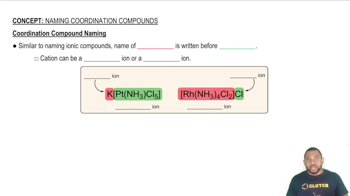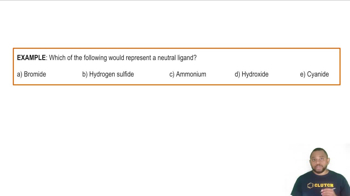Ch.23 - Transition Metals and Coordination Chemistry

Brown15th EditionChemistry: The Central ScienceISBN: 9780137542970Not the one you use?Change textbook
Chapter 23, Problem 35
Complete the exercises below. Write the formula for each of the following compounds, being sure to use brackets to indicate the coordination sphere: e. bis(ethylenediamine)zinc(II) tetraiodomercurate(II).
 Verified step by step guidance
Verified step by step guidance1
Identify the components of the compound: The compound is a coordination complex consisting of a cation and an anion. The cation is 'bis(ethylenediamine)zinc(II)' and the anion is 'tetraiodomercurate(II)'.
Determine the formula for the cation: 'bis(ethylenediamine)zinc(II)' indicates that zinc is coordinated with two ethylenediamine ligands. Ethylenediamine is a bidentate ligand with the formula (NH2CH2CH2NH2). Zinc(II) has a charge of +2. The formula for the cation is [Zn(en)2]^{2+}, where 'en' represents ethylenediamine.
Determine the formula for the anion: 'tetraiodomercurate(II)' indicates that mercury is coordinated with four iodide ions. Mercury(II) has a charge of +2, and each iodide ion has a charge of -1. The formula for the anion is [HgI4]^{2-}.
Combine the cation and anion to form the neutral compound: Since both the cation and anion have charges of ±2, they combine in a 1:1 ratio to form a neutral compound.
Write the complete formula for the compound: The formula is written as [Zn(en)2][HgI4], with the cation and anion enclosed in brackets to indicate the coordination spheres.
Key Concepts
Here are the essential concepts you must grasp in order to answer the question correctly.
Coordination Compounds
Coordination compounds consist of a central metal atom or ion bonded to surrounding molecules or ions, known as ligands. The arrangement of these ligands around the metal center forms a coordination sphere, which is crucial for determining the compound's properties and reactivity. Understanding how to represent these compounds, including the use of brackets to denote the coordination sphere, is essential for accurately writing their formulas.
Recommended video:
Guided course

Coordination Compound Naming
Ligands
Ligands are ions or molecules that can donate a pair of electrons to a central metal atom to form a coordinate bond. In the given compound, 'bis(ethylenediamine)' indicates that two ethylenediamine molecules act as bidentate ligands, each forming two bonds with the zinc ion. Recognizing the nature and number of ligands is vital for constructing the correct formula of coordination compounds.
Recommended video:
Guided course

Ligands Example
Oxidation States
The oxidation state of an element in a compound indicates its degree of oxidation or reduction, which is essential for understanding the compound's overall charge. In the question, zinc is in the +2 oxidation state, while the tetraiodomercurate(II) complex also has a -2 charge. Accurately determining and balancing these oxidation states is crucial for writing the correct formula of the coordination compound.
Recommended video:
Guided course

Oxidation Numbers
Related Practice
